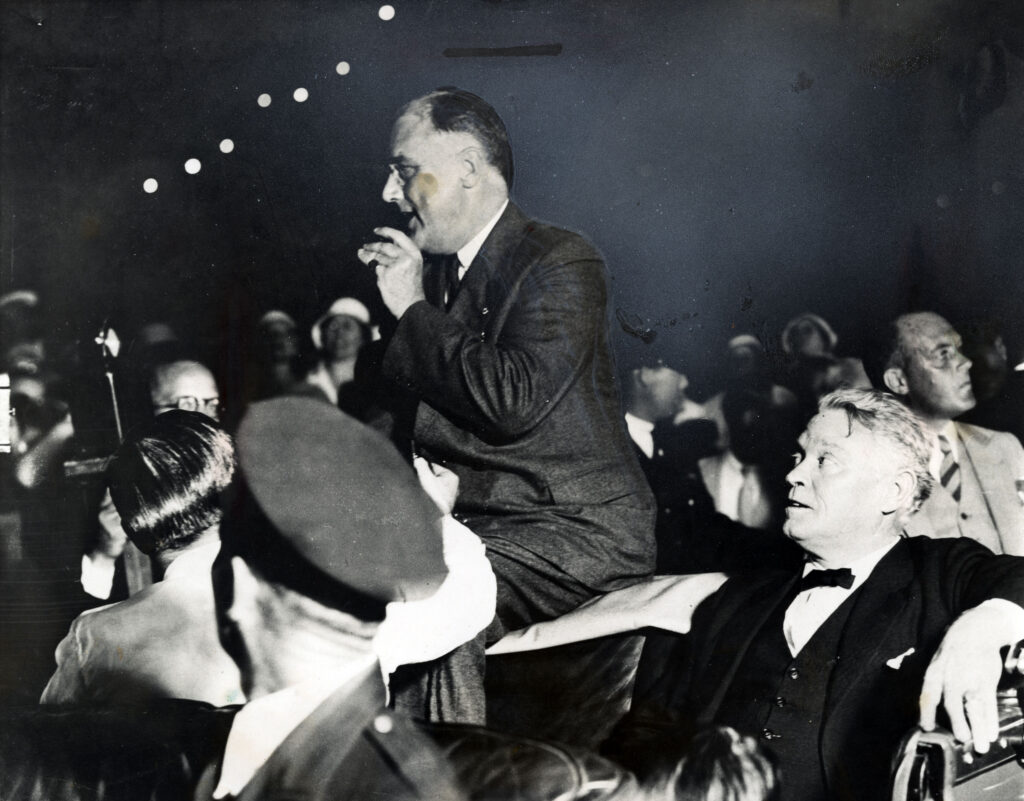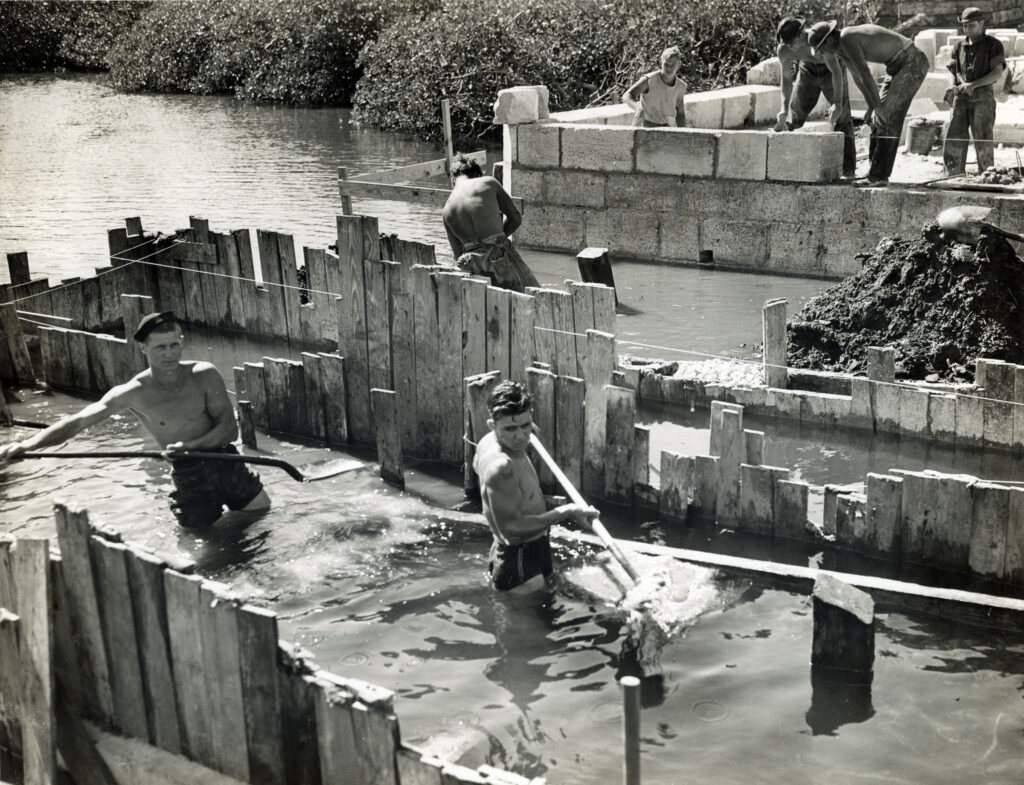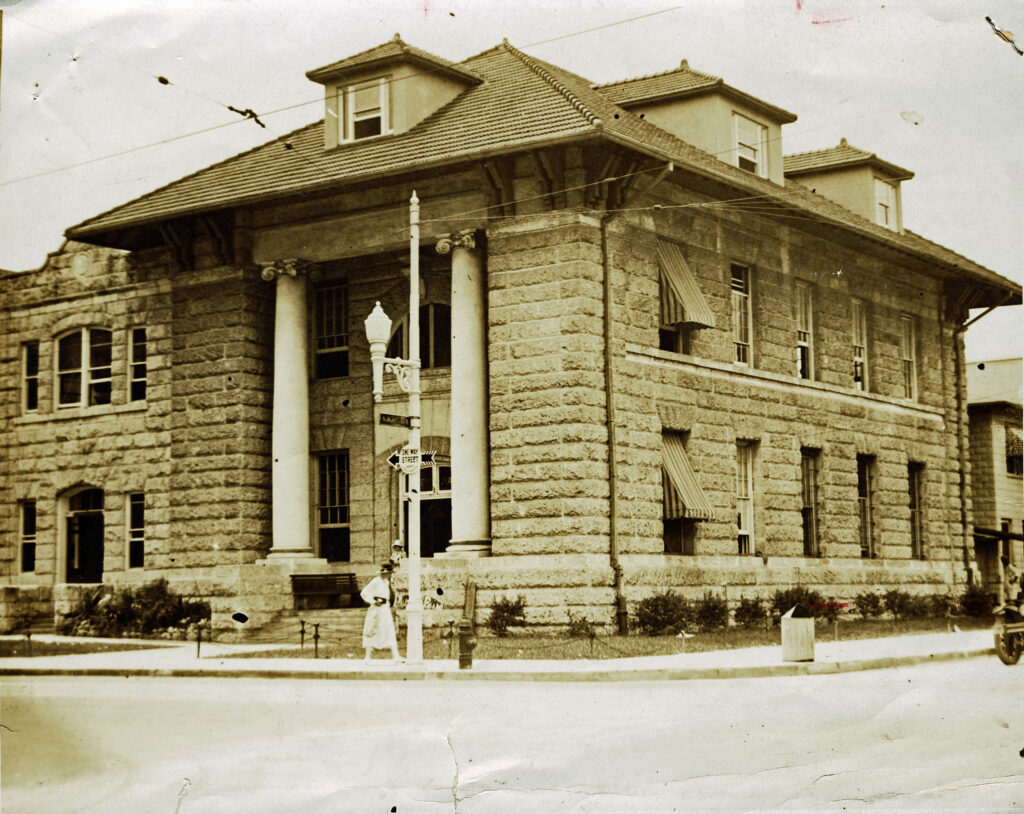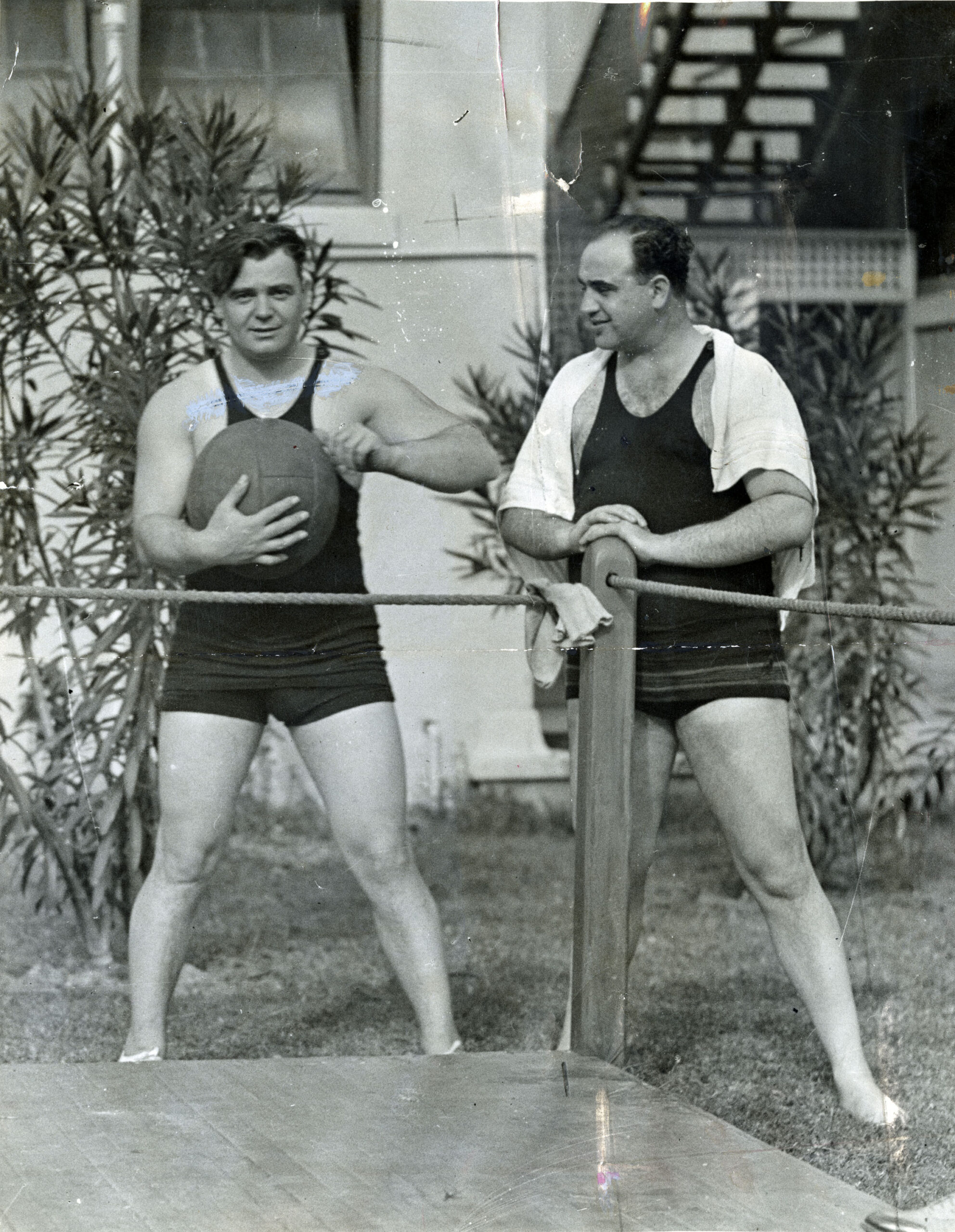By Paul S. George, Ph.D.
The collapse of the stock market in October 1929 ushered in the Great Depression and brought an abrupt end to America’s Jazz Age. The Great Depression, the worst economic crisis in American history, was marked by massive bank failures, factory closings, rampant joblessness, deflation and a growing despair among the populace that good times would never return. Greater Miami exhibited each of these characteristics in a decade long economic struggle.
In 1930, two of Miami’s largest banks failed as many Miamians lost their savings in this financial collapse. Only the First National Bank of Miami remained solvent under the leadership of Ed Romfh, a highly-respected banker and former mayor of Miami. In the immediate aftermath of the latest bank failure, the closing of the Bank of Bay Biscayne, the city’s oldest bank, crowds of panicky Miamians jammed the E. Flagler Street lobby of the First National Bank. Above the crowd from the vantage point of his mezzanine level office, Romfh spoke in a calm and reassuring voice. He invited nervous depositers to withdraw their savings while assuring all within earshot that his bank was solvent; many withdrew their savings; others took Romfh at his word and kept their money there. Many who did withdraw their money then hurried to the nearby United States Post Office in the Federal Building at the intersection of Northeast First Avenue and First Street to purchase money orders. Throughout the day, the Post Office treasurer sent his men back through the bank’s rear door to make cash deposits collected from people using postal money orders to conduct transactions in that era of widespread bank failures. This practice brought a large infusion of cash to the downtown post office, and, ultimately, to the First National Bank of Miami, its repository, reinforcing Romfh’s confidence that his bank would survive the financial crisis.
In fact, Ed Romfh was so confident of his bank solvency, that his was the only bank in the United States that refused to close on the bank holiday declared by President Franklin D. Roosevelt on March 6, 1933, two days after his first inauguration. Romfh’s First National Bank of Miami would continue to flourish in the years and decades following the Great Depression.

Shows President-elect Roosevelt speaking a Buick convertible. February 15, 1933; HistoryMiami Museum archives.
Franklin Roosevelt played an outsized role in U.S. history and even that of Greater Miami. After enjoying an extended pre-inauguration vacation highlighted by fishing expeditions in the waters around Miami and south Florida, the incoming president agreed to speak on February 15, 1933 in Bayfront Park, a popular green space in the process of becoming the city’s “front porch.” Even with the nation’s banking system in a free fall, a jovial Roosevelt spoke briefly from a tourister car parked at the edge of the park’s bandshell. Immediately after, he completed his remarks shots rang out from one of the front rows of seating at the bandshell. Guiseppe Zangara, a troubled, self-styled anarchist, who blamed his chronic stomach pain on, among other things, heads of state, was the shooter. While Roosevelt escaped the assassin’s bullets five persons, including Anton Cermak, the mayor of Chicago, were not so lucky. Cermak succumbed to his gunshot womb less than three weeks later. Zangara, an Italian immigrant, pled guilty to murder; he was sentenced to death and died in the electric chair in the Florida State Prison at Raiford just five weeks after the crime.
Almost immediately after his inauguration, President Roosevelt, working with overwhelming Congressional support, began implementing the New Deal, his program for fighting the Great Depression, one far more vigorous than that of his failed predecessor Herbert Hoover’s approach to combatting the economic malaise and rising hopelessness that had settled over the country since 1929. Highlighting the New Deal were a series of agencies and programs to put unemployed Americans to work in meaningful jobs to improve the country’s natural and built environment, its culture, entertainment, learning, etc. The funding agency here was the Federal Emergency Relief Agency (FERA). Through its efforts 16,000 greater Miamians received federal assistance.
The Works Progress Administration (WPA), the largest of the New Deal agencies, hired unemployed writers to produce a valuable guidebook to Miami. Musicians looking for work provided music under the auspices of the WPA in different venues of the city. Artists and architects drew murals for courtrooms, schools and other public buildings under the auspices of the WPA.

CCC workers constructing facilities (Matheson Hammock), circa 1930. HistoryMiami Museum archives.
Other agencies included the Civilian Conservation Corps (CCC), which built the verdant Matheson Hammock Park and Greynolds Park, two of Dade’s premier parks. The CCC also constructed components of Fairchild Tropical Garden, lying next door to Matheson Hammock. Another “alphabet” agency, the Public Works Administration (PWA), built numerous new public buildings, including the Art Deco styled Miami Beach Post Office, Coral Gables Woman’s Club and Library and Coral Way and Miami Shores Elementary schools, each an architectural gem bearing the streamline style of the 1930s. The PWA also constructed Liberty Square in Liberty City, which was one of the first public housing projects in America. But the PWA’s most famous construction project was Roddy Burdine Stadium, named for the great merchant prince of retail and president of his eponymous stores. Originally a 24,000 steel and concrete arena, it would host from its opening in 1937 until its demolition in 2008 many of America’s most monumental football contests and other noteworthy events. Long before then, in 1949, it was renamed the Orange Bowl for the New Year’s Day classic that emanated from it.
The New Year’s Day Orange Bowl game, which began in 1933 as the Palm Festival, was one of the most important of numerous events designed to draw visitors to the area and provide them with first rate entertainment. The Palm Festival became the Orange Bowl festival a few years after its inception. By the late 1930s, its New Year’s Day games were broadcast nationally. The festival quickly added a New Year’s Eve (held initially in the afternoon) parade to its offerings, and, later, many other events. The parade and the floats comprising it rumbled through the streets of downtown Miami to the entertainment of thousands of onlookers. The annual All American Air Maneuvers, held in an airfield in northwest Dade County, featuring skilled pilots of both genders engaged in daring maneuvers, also wowed large audiences of aerial enthusiasts from their beginnings in the late 1920s until America’s entry into World War II in the early 1940s (and briefly after the conflict).
Al Capone and another man in wrestling suits next to an outdoor ring. HistoryMiami Museum archives.
Other tourists and locals turned to gambling as an activity that plagued the city and region into the 1950s and beyond. Organized crime entered Miami and its environs in the 1920s, when the Capone gang used the area as a source for bootleg liquor, which flowed into Greater Miami in unimpeded fashion from Bimini and other parts of the Bahamas. Gambling replaced rumrunning as the most important syndicated criminal activity after the termination of National Prohibition in 1933. Gambling clubs arose throughout south Florida, including the city of Miami, Miami Beach and other parts of the county. Major crime figures, Meyer Lansky and his brother Jake Lansky, members of the old Capone Gang, and the S&G Syndicate, operating out of a posh office on Lincoln Road, were behind the operations of many clubs and other gambling operations.
Legalized gambling was also pervasive, with pari-mutuel wagering at venues offering horse and dog racing, as well as jai alai. The Florida legislature even legalized slot machine gambling for two years in the mid-1930s, easing the way for the ubiquity of these devices throughout the area.
These offerings, along with the area’s weather and waters, led to a steady rise in tourism, enabling greater Miami to confront the challenges of the Great Depression more successfully than many other parts of the country. Many tourists arrived on one of the two railroad lines serving the area as well as by airplane. Pan American Airways and Eastern Airlines led the way with both establishing their headquarters here. Out of this development arose Pan American Field, later known as the 36th Street Airport, and still later as Miami International Airport. Pan American Field rested on the south side of N.W. 36th Street near 52nd Avenue before developing in an easterly direction. By 1934, Pan American Airways had built a stunning Art Deco-styled building for its growing fleet of seaplanes at Dinner Key in Coconut Grove. The carrier’s busy seaplanes not only moved passengers and cargo, especially mail, to growing destinations north and south but these machines and their striking terminal also became major tourist attractions!

Miami City Hall and Police Station, 1920. Miami News Photograph Collection, HistoryMiami Museum archives.
The Pan American terminal at Dinner Key closed in 1946, and for the past seventy year has served as Miami City Hall. Like other municipalities, the city of Miami has had its share of political volatility, and even rancor, in this building, as well as those city halls that predated it. The late 1930s were especially notable for a pervasive discontent by residents toward their elected officials. In 1938, fed-up Miami citizens advocated for the dismissal from office through a special recall election of Mayor Robert Williams and City Commissioners John DuBose and Ralph B. Ferguson, members of the “Termite Commission,” so named by their detractors because of their alleged corruption, heavy handedness with municipal employees, contempt for public opinion and under the table deal making, all of which, in the view of many, were eating away, like termites, at the freedoms of Miamians.
In the same year as the call for a recall election, members of the Termite Commission found themselves with additional problems as Williams and DuBose were tried, but ultimately acquitted, in the Florida Power & Light bribery case, as it was known. Williams and DuBose (Ferguson was charged, too, but the allegations against him were dropped due to a lack of evidence) had allegedly solicited, through a representative, a bribe payment of $250,000 from the power company in return for a settlement of all rate litigation matters on the company’s own terms out of court. In the following year, 1939, and on the heels of these acquittals, the recall election was held despite the energetic efforts of these officials to prevent it. Williams, Ferguson and Dubose were subsequently voted out of office by commanding majorities in the city’s first recall election. For its role in investigating the actions of the Termite Commission and setting the stage for the exit of three commission members, the Miami Daily News won its first Pulitzer Prize for the “most disinterested and meritorious public service rendered by any newspaper during the year.” Among the Miami Daily News staff involved in investigating the mayor and commission was Ann Mergen, whose searing political cartoons critiqued the actions of these municipal leaders. Mergen is believed to have been the first woman editorial cartoonist in the country drawing for a daily newspaper.

